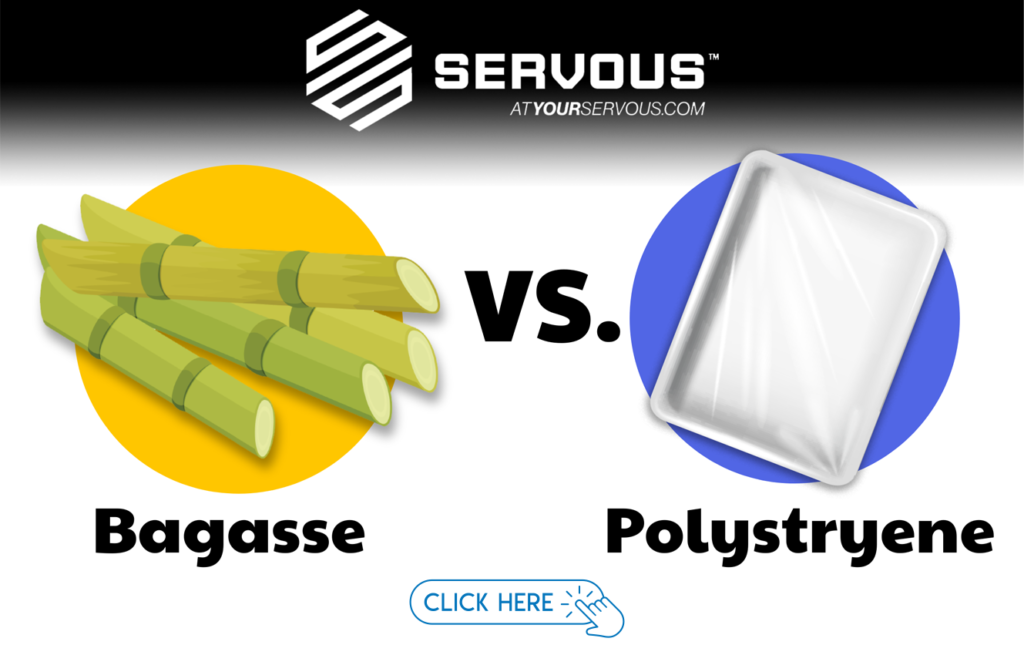When it comes to choosing the best food packaging material, you have no shortage of options. In addition to traditional plastic materials, you can choose from an ever-expanding selection of premium sustainable food packaging solutions and alternatives. And among the most popular and beneficial eco-friendly materials are sugarcane bagasse packaging or sugarcane products.
At Servous, we are proud to be the leading supplier of different types of food packaging supplies. We always take a consultative process in helping our clients find the best, most suitable food packaging material and supplies.
As industry leaders, one of the most frequently asked questions we receive involves the difference between sugarcane bagasse vs polystyrene vs Styrofoam food packaging supplies. Let’s take a closer look at each.

What Are Bagasse Products?
Bagasse products are highly-renewable and a sustainable food packaging material that has proven to be a viable alternative to plastic. Bagasse is the tough sugarcane fiber that remains after sugarcane stalks have been processed and sugar is produced.
While other food packaging supplies rely on the use of nonrenewable resources, bagasse products are byproducts of manufacturing sugar cane stalks.
What Is Styrofoam vs Expanded Polystyrene?
Styrofoam is the trademarked name by the Dow Chemical Company for the chemical compound polystyrene. Real Styrofoam products are designed for rugged and durable building applications.
Styrofoam is a petroleum-based plastic material that is manufactured from styrene monomer, which means it’s extremely lightweight and is around 95% air. Due to the amount of air, Styrofoam products boast excellent insulation properties, are unsinkable, and can maintain their form.
While most people think Styrofoam is used for food packaging, the material used in food service and Styrofoam are not the same material. Instead, the material used in the foodservice industry is expanded polystyrene foam.
As food packaging Styrofoam alternatives, polystyrene products boast an air composition that ranges anywhere from 96 to 98% air 2 – 4% polystyrene. This makes polystyrene perfect for cold foods, paper cups, and more.
What Are the Benefits of Sugarcane Fiber Bagasse Food Packaging?
When you choose food packaging products made from bagasse sugarcane fiber, you’ll enjoy a reliable, highly durable, and eco-friendly product. In addition, bagasse sugarcane fiber products offer a range of enticing benefits.
- Sugarcane fiber products offer a host of environmental benefits
- Perfect for raw or prepared meats
- Offer excellent durability
- Bagasse food trays are soak proof
- Requires no wax lining or plastic lining
- They’re highly resistant to moisture and grease
- Extremely sturdy and can resist flexibility
- Available in white and natural color
- Completely compostable and biodegradable to generate less waste
What Are the Benefits of Polystyrene Foam Food Packaging?
Polystyrene foam packaging offers a plethora of admirable qualities and attributes, such as:
- Ability to resist moisture
- Provides excellent thermal insulation
- Excellent portability and lightweight
- Easily recyclable to reduce waste
- Excellent durability
- Easily brandable by printing and adhesive labeling
- Versatile in strength
- Cost-effectiveness
- Available in different sizes and shapes
- Resistant to compressions
- High-shock absorbency
Food Safety: Bagasse vs Polystyrene Foam Packaging?
When it comes to safety, both sugarcane fiber bagasse products and polystyrene foam packaging are safe. Polystyrene foam has been used safely to package and store food for almost 50 years.
Polystyrene materials are so safe they are often used in the medical industry where the highest levels of hygiene are required. On the other hand, bagasse products are the result of processing sugarcane stalks. This makes sugarcane fiber products extremely safe.
Types of Food Packaging Products: Sugarcane Bagasse vs Polystyrene Foam
Bagasse sugarcane fiber products and polystyrene foam are both used to make a broad range of products. Even though bagasse sugarcane products are a relatively new food packaging solution, it’s often used in:
- Bagasse Sugarcane Meat Trays
- Bagasse Sugarcane Chicken Roaster containers
- Bagasse Sugarcane Plates
- Bagasse Sugarcane Bowls
- Bagasse Sugarcane Produce Trays
- Bagasse Sugarcane Take-out food containers
- Bagasse Sugarcane Paper Shopping Bags
- And more
Polystyrene has been used in the food service industry for nearly 50 years, and some of the most common applications include:
- Polystyrene hinged dinner containers
- Foam plates
- Foam plates
- Foam clamshell containers
- Polystyrene cups
- Polystyrene produce trays
- And more
Recyclability: Polystyrene Foam vs Bagasse
Surprisingly, both bagasse and polystyrene foam are recyclable materials.
Bagasse Is Recyclable
One of the most attractive benefits of choosing bagasse is the material’s eco-friendly nature. In fact, bagasse is 100% recyclable.
Polystyrene Foam Products Are Recyclable
However, most people are surprised to learn that polystyrene foam can be recycled, which prevents it from entering a landfill. If you were to look at the bottom of your polystyrene foam food containers, you’ll see the symbol of 6, which means the material can be recycled.
When polystyrene foam is recycled, it is broken down into smaller pieces and then can be extruded into pellets that can be transformed into a range of different products. Examples of products that are manufactured with post-consumer recycled content include:
- Seedling containers
- Outdoor furniture
- Roofing tiles
- Coat hangers
- Packaging peanuts
- And more
Eco-Friendliness: Bagasse vs Polystyrene Foam Food Packaging
In terms of sustainability, cornstarch and bagasse food packaging products are among the most eco-friendly on the planet.
Bagasse Production Requires Less Energy
The production of bagasse uses less energy and generates less waste, which alone makes it one of the most eco-friendly options available.
Bagasse Is Plentiful
In addition to requiring less energy for production, bagasse is extremely environmentally friendly because it’s readily available and plentiful. There are over two times as much fibrous bagasse pulp created from sugarcane production when compared to the resulting cane sugar.
Bagasse Is a Top Sustainable Alternatives
Because sugarcane products are extremely renewable, bagasse doesn’t require the use of fossil fuels or virgin wood. This can help reduce the carbon footprint of your business to meet the emerging demands of more environmentally-friendly customers.
Bagasse Is 100% Biodegradable
Being biodegradable means it will naturally break down and decompose into elements that are safe and natural to the environment. This helps prevent it from taking up space at your local landfill.
Bagasse Is 100% Compostable
Being compostable means it will break down into organic matter when the composting conditions are ideal, such as in a commercial composting facility. Once composted, bagasse can function as fertilizer to enhance soil quality.
Polystyrene Products Are Less Renewable
On the other hand, polystyrene foam products require more energy to produce and are less renewable. Polystyrene plates, cups, and other products are manufactured from oil
Contact Servous for Food Packaging Products
We get it — trying to decide the best food packaging materials for your foodservice restaurant can be confusing. However, when you partner with Servous, we will make the process easy. We offer a consultative process designed to get to know your business, budget, and goals. Then we can guide you to the best, most cost-efficient solution.
Contact Servous today for the best food packaging products and solutions.











